Audio Message from Standalone IP Speaker: Difference between revisions
From Zenitel Wiki
No edit summary |
|||
| Line 22: | Line 22: | ||
# Upload and configure the Audio Message | # Upload and configure the Audio Message | ||
# Configure the inputs | # Configure the inputs | ||
===Setting up as Edge controller=== | ===Setting up as Edge controller=== | ||
[[Logging_into_an_IP_Station|Log in to the IP Speaker]], and go to '''Main Settings'''. Enable “Edge Controller”, and set a Static IP address: | [[Logging_into_an_IP_Station|Log in to the IP Speaker]], and go to '''Main Settings'''. Enable “Edge Controller”, and set a Static IP address: | ||
| Line 45: | Line 47: | ||
</table> | </table> | ||
==Upload and configure audio message == | ===Upload and configure audio message === | ||
[[Logging_into_an_IP_Station|Log in to the Edge Controller]], and go to '''System Configuration''' > '''Special Settings'''. Under '''Audio Messages''', select "Show Settings". | [[Logging_into_an_IP_Station|Log in to the Edge Controller]], and go to '''System Configuration''' > '''Special Settings'''. Under '''Audio Messages''', select "Show Settings". | ||
| Line 90: | Line 79: | ||
{{note|The wav file must be 16kHz sample rate, 16 bit resolution, mono}} | {{note|The wav file must be 16kHz sample rate, 16 bit resolution, mono}} | ||
===The inputs=== | |||
The inputs 1 and 2 are used to start and stop the message. This is done by calling nonexistent numbers and the stop message function. | |||
<table style="max-width:80%; border-style: double; border-color: #c7c7c7;"> | |||
<tr style="rowspan:2;"> | |||
<td style="display: block; vertical-align: bottom;">[[Image:Inputs V2.png|700px]]</td> | |||
</tr> | |||
<tr> | |||
<td style='background-color:#efefef;'>Configuring the inputs</td> | |||
</tr> | |||
</table> | |||
The call of course will fail but still generate an “'''call ended'''” event. That we will utilize for the audio messages. | |||
==Multiple messages== | ==Multiple messages== | ||
Revision as of 10:49, 25 March 2022
This article describes how a Zenitel IP Speaker can be used to play a prerecorded message, triggered by a push button. The message can play once and then stop, or the message can play in loop and a second button can be used to stop the message.
Hardware wiring
For the man overboard we will have two buttons:
- One to start playing the message
- One to stop playing the message
Since it is a standalone speaker there is no network, except when configuring. Inside the speaker there is a TKIS-2 kit. This is displayed in the picture below.
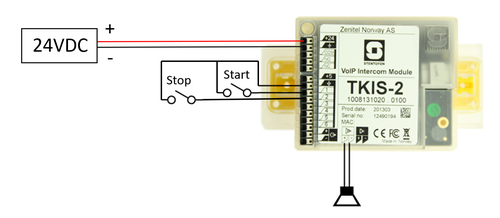 |
| Wiring the TKIS-2 inside the speaker |
Configuration steps
- Set the IP Speaker as an Edge Controller
- Upload and configure the Audio Message
- Configure the inputs
Setting up as Edge controller
Log in to the IP Speaker, and go to Main Settings. Enable “Edge Controller”, and set a Static IP address:
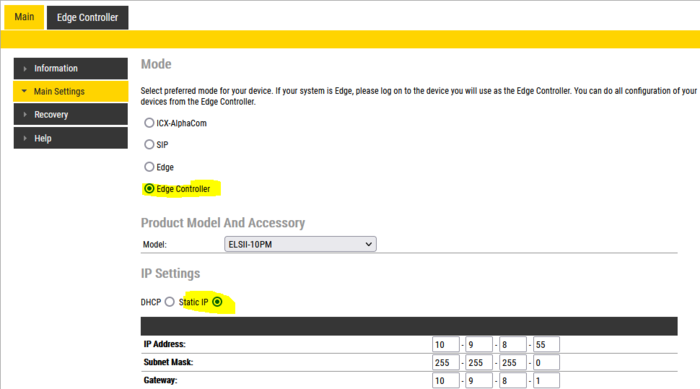 |
| Setting as the Edge Controller |
Next is to give the IP Speaker a number in the Directory so it registers to itself. Go to Edge controller, System configuration, Directory:
 |
| Assigning the directory number |
Upload and configure audio message
Log in to the Edge Controller, and go to System Configuration > Special Settings. Under Audio Messages, select "Show Settings".
Browse to the wav file, and Upload the file.
Next step is to link the audio message to a (non-existing) call number. When a call is initiated to this number, and the call fails, the linked message will be played. Good practice is to use number 501 = Message 1 (and 502 = Message 2 etc. if more messages).
In the screenshot below the message will play in loop when a call is made to numbers 501. The message is stopped by making a call to number 599:
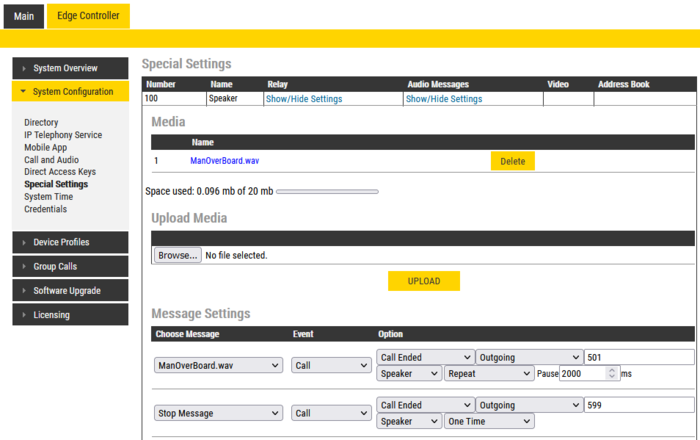 |
| Message linked to call number 501. Message will play in loop. Stop the message by calling 599. |
Instead of looping the message, it can play once then stop. In the screenshot below the message will play once, then stop, when a call is made to numbers 501:
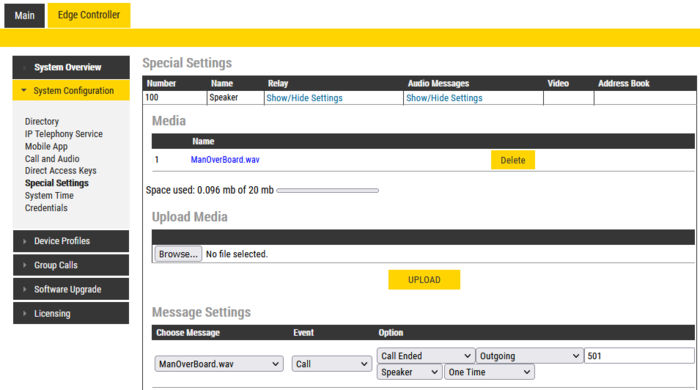 |
| Message linked to call number 501. Message will play once. |
The inputs
The inputs 1 and 2 are used to start and stop the message. This is done by calling nonexistent numbers and the stop message function.
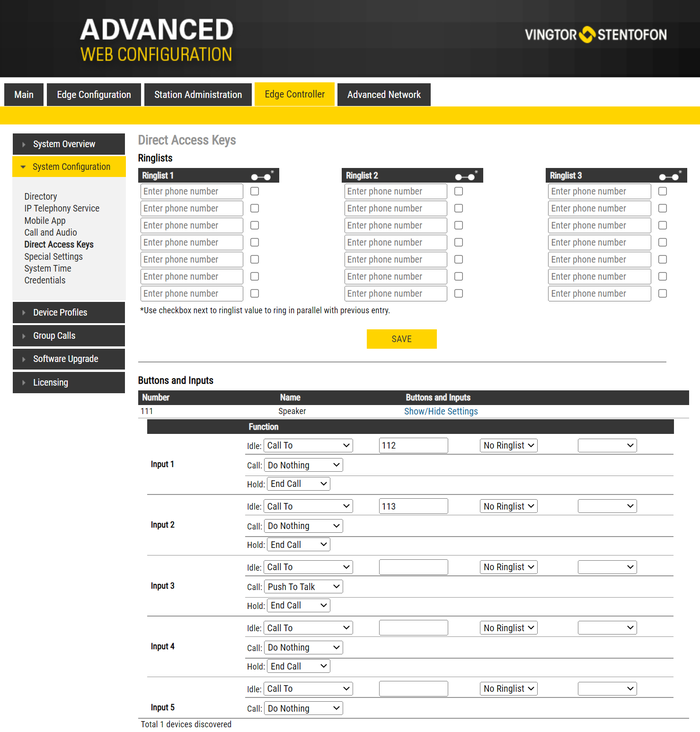 |
| Configuring the inputs |
The call of course will fail but still generate an “call ended” event. That we will utilize for the audio messages.
Multiple messages
If multiple messages are wanted, one can assign more inputs to fake numbers (e.g. 501, 502, 503 etc.) and use the same method “call ended” event to start the messages. You still need only one stop message.


